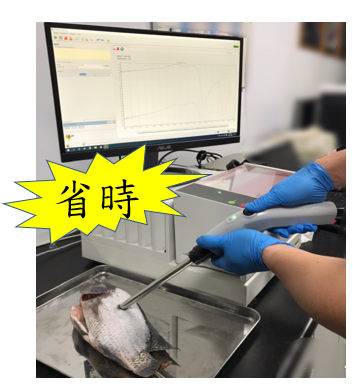News
Real-time mobile detection of aquatic product freshness
- PostDate:2022-04-01
The Fisheries Research Institute has developed a rapid detection method to determine the volatile basic nitrogen (VBN) in aquatic products with near-infrared spectroscopy (NIRS), and the identification rate is up to 88.3%. As a quality control tool for aquatic product suppliers, fresh food supermarkets, and group meal suppliers, this method can quickly and accurately determine the freshness of aquatic products without destructiveness, thus, providing safe and secure food.
According to the Fisheries Research Institute, in various stages of the low temperature circulation (cold chain) of aquatic products from the origin, auction, transportation, and storage to sale, temperature fluctuations during storage and transportation or improper preservation is likely to accelerate their decomposition and may affect human health. The freshness of an aquatic product is a key factor affecting its quality and selling price, thus, a fast real-time freshness determination method can be applied to production and management in food factories and maintain food safety for consumers.
The Fisheries Research Institute explained that VBN is one of the legal indicators for judging the freshness of aquatic products. However, when testing with the traditional method, multiple steps are required, such as fish meat breaking, homogenization, extraction, and analysis, which are both time-consuming (about four hours) and destructive. NFR is a fast (about 30-60 seconds), accurate, and non-destructive analytical method without chemical analysis. With tilapia as the model fish, the Fisheries Research Institute used NIR to scan the fish body and simultaneously measured the VBN value of the fish meat. Then, 1,080 sets of spectrum diagrams and their corresponding VBN values were used to train the machine learning to interpret the freshness of the fish meat with MAtrix LABoratory (MATLAB) software and establish a module. The VBN values listed in the regulation were used as the standard of this study for freshness classification and screening, and the results showed that the module recognition rate reached up to 88.3%, which is above the level of a good recognition rate (85%).
The Institute used NIR to develop a fish freshness module as a rapid detection tool. The data accumulated in the atlas database in combination with the calculation module has replaced the traditional freshness analysis method, which is time-consuming and destructive. Moreover, it can also be used for rapid and non-destructive detection of the freshness of aquatic products to ensure the edible safety of the products. While the Fisheries Research Institute is currently using tilapia as the model fish, it will continue to expand to other large catches in the future to increase the database in order to optimize its identification rate. This calculation module is expected to be used as a tool for rapid freshness detection.
Seafood Technology Division under the Fisheries Research Institute, Council of Agriculture, Executive Yuan

Figure 1. Volatile basic nitrogen (VBN) inspection process of fishery products

Figure 2. Process of building spectrum diagrams with handheld NIR scanning (tilapia)


